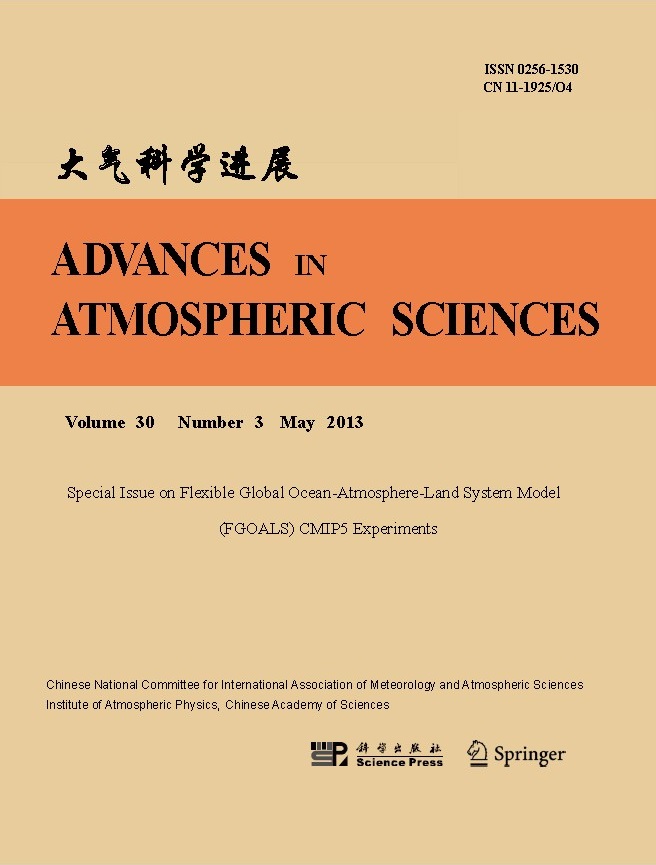| [1] |
ZHOU Baiquan, NIU Ruoyun, ZHAI Panmao,
2015: An Assessment of the Predictability of the East Asian Subtropical Westerly Jet Based on TIGGE Data, ADVANCES IN ATMOSPHERIC SCIENCES, 32, 401-412.
doi: 10.1007/s00376-014-4026-2
|
| [2] |
Sun Shuqing,
1985: GRAVITY WAVES ON THE AXIS OF LOW LEVEL JET AND THEIR INSTABILITY, ADVANCES IN ATMOSPHERIC SCIENCES, 2, 112-123.
doi: 10.1007/BF03179743
|
| [3] |
LI Chaofan, LIN Zhongda,
2015: Predictability of the Summer East Asian Upper-Tropospheric Westerly Jet in ENSEMBLES Multi-Model Forecasts, ADVANCES IN ATMOSPHERIC SCIENCES, 32, 1669-1682.
doi: 10.1007/s00376-015-5057-z
|
| [4] |
XU Tengfei, YUAN Dongliang, YU Yongqiang, and ZHAO Xia,
2013: An assessment of Indo-Pacific oceanic channel dynamics in the FGOALS-g2 coupled climate system model, ADVANCES IN ATMOSPHERIC SCIENCES, 30, 997-1016.
doi: 10.1007/s00376-013-2131-2
|
| [5] |
GUO Lanli, ZHANG Yaocun, WANG Bin, LI Lijuan, ZHOU Tianjun, BAO Qing,
2008: Simulations of the East Asian Subtropical Westerly Jet by LASG/IAP AGCMs, ADVANCES IN ATMOSPHERIC SCIENCES, 25, 447-457.
doi: 10.1007/s00376-008-0447-0
|
| [6] |
ZHANG Yaocun, HUANG Danqing,
2011: Has the East Asian Westerly Jet Experienced a Poleward Displacement in Recent Decades?, ADVANCES IN ATMOSPHERIC SCIENCES, 28, 1259-1265.
doi: 10.1007/s00376-011-9185-9
|
| [7] |
ZHANG Lixia* and ZHOU Tianjun, ,
2014: An Assessment of Improvements in Global Monsoon Precipitation Simulation in FGOALS-s2, ADVANCES IN ATMOSPHERIC SCIENCES, 31, 165-178.
doi: 10.1007/s00376-013-2164-6
|
| [8] |
LI Chun, SUN Jilin,
2015: Role of the Subtropical Westerly Jet Waveguide in a Southern China Heavy Rainstorm in December 2013, ADVANCES IN ATMOSPHERIC SCIENCES, 32, 601-612.
doi: 10.1007/s00376-014-4099-y
|
| [9] |
Xiaowei HONG, Riyu LU, Shuanglin LI,
2018: Asymmetric Relationship between the Meridional Displacement of the Asian Westerly Jet and the Silk Road Pattern, ADVANCES IN ATMOSPHERIC SCIENCES, 35, 389-397.
doi: 10.1007/s00376-017-6320-2
|
| [10] |
Sining LING, Riyu LU, Hao LIU, Yali YANG,
2023: Interannual Meridional Displacement of the Upper-Tropospheric Westerly Jet over Western East Asia in Summer, ADVANCES IN ATMOSPHERIC SCIENCES, 40, 1298-1308.
doi: 10.1007/s00376-022-2279-8
|
| [11] |
Xinyu LI, Riyu LU, Gen LI,
2021: Different Configurations of Interannual Variability of the Western North Pacific Subtropical High and East Asian Westerly Jet in Summer, ADVANCES IN ATMOSPHERIC SCIENCES, 38, 931-942.
doi: 10.1007/s00376-021-0339-0
|
| [12] |
KUANG Xueyuan, ZHANG Yaocun,
2005: Seasonal Variation of the East Asian Subtropical Westerly Jet and Its Association with the Heating Field over East Asia, ADVANCES IN ATMOSPHERIC SCIENCES, 22, 831-840.
doi: 10.1007/BF02918683
|
| [13] |
XUAN Shouli, ZHANG Qingyun, SUN Shuqing,
2011: Anomalous Midsummer Rainfall in Yangtze River-Huaihe River Valleys and Its Association with the East Asia Westerly Jet, ADVANCES IN ATMOSPHERIC SCIENCES, 28, 387-397.
doi: 10.1007/s00376-010-0111
|
| [14] |
LU Riyu, YE Hong, Jong-Ghap JHUN,
2011: Weakening of Interannual Variability in the Summer East Asian Upper-tropospheric Westerly Jet since the Mid-1990s, ADVANCES IN ATMOSPHERIC SCIENCES, 28, 1246-1258.
doi: 10.1007/s00376-011-0222-5
|
| [15] |
Yuhan YAN, Chaofan LI, Riyu LU,
2019: Meridional Displacement of the East Asian Upper-tropospheric Westerly Jet and Its Relationship with the East Asian Summer Rainfall in CMIP5 Simulations, ADVANCES IN ATMOSPHERIC SCIENCES, 36, 1203-1216.
doi: 10.1007/s00376-019-9066-1
|
| [16] |
Zhongda LIN, Yuanhai FU, Riyu LU,
2019: Intermodel Diversity in the Zonal Location of the Climatological East Asian Westerly Jet Core in Summer and Association with Rainfall over East Asia in CMIP5 Models, ADVANCES IN ATMOSPHERIC SCIENCES, 36, 614-622.
doi: 10.1007/s00376-019-8221-z
|
| [17] |
LIN Pengfei, YU Yongqiang, and LIU Hailong,
2013: Oceanic Climatology in the Coupled Model FGOALS-g2: Improvements and Biases, ADVANCES IN ATMOSPHERIC SCIENCES, 30, 819-840.
doi: 10.1007/s00376-012-2137-1
|
| [18] |
SONG Fengfei, and ZHOU Tianjun,
2013: FGOALS-s2 Simulation of Upper-level Jet Streams over East Asia: Mean State Bias and Synoptic-scale Transient Eddy Activity, ADVANCES IN ATMOSPHERIC SCIENCES, 30, 739-753.
doi: 10.1007/s00376-012-2212-7
|
| [19] |
ZHOU Tianjun, SONG Fengfei, and CHEN Xiaolong,
2013: Historical Evolution of Global and Regional Surface Air Temperature Simulated by FGOALS-s2 and FGOALS-g2: How Reliable Are the Model Results?, ADVANCES IN ATMOSPHERIC SCIENCES, 30, 638-657.
doi: 10.1007/s00376-013-2205-1
|
| [20] |
Yaqi WANG, Zipeng YU, Pengfei LIN, Hailong LIU, Jiangbo JIN, Lijuan LI, Yanli TANG, Li DONG, Kangjun CHEN, Yiwen LI, Qian YANG, Mengrong DING, Yao MENG, Bowen ZHAO, Jilin WEI, Jinfeng MA, Zhikuo SUN,
2020: FGOALS-g3 Model Datasets for CMIP6 Flux-Anomaly-Forced Model Intercomparison Project, ADVANCES IN ATMOSPHERIC SCIENCES, 37, 1093-1101.
doi: 10.1007/s00376-020-2045-8
|















 AAS Website
AAS Website 
 AAS WeChat
AAS WeChat 
 DownLoad:
DownLoad: